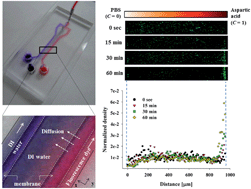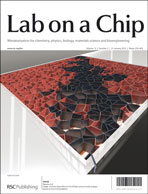Quantitatively controlled in situ formation of hydrogel membranes in microchannels for generation of stable chemical gradients†
Abstract
The in situ formation of membranes in microfluidic channels has been given attention because of their great potential in the separation of components, cell culture support for tissue engineering, and molecular transport for generation of chemical gradients. Among these, the porous membranes in microchannels are vigorously applied to generate stable chemical gradients for chemotaxis-dependent cell migration assays. Previous work on the in situ fabrication of membranes for generating the chemical gradient, however, has had several disadvantages, such as fluid leaking, uncontrollable membrane thickness, need of extra equipment, and difficulty in realizing stable interfacial layers. In this paper, we report a novel technique for the in situ formation of membranes within microchannels using enzymatically crosslinkable hydrogels and microfluidic techniques. The thickness of the membrane can be controlled quantitatively by adjusting the crosslinking reaction time and velocity of the microfluidics. By using these techniques, parallel dual hydrogel membranes were prepared within microchannels and these were used for the generation of stable concentration gradients. Moreover, the migration of Salmonella typhimurium was monitored to validate the efficacy of the chemical gradients. These results suggest that our in situmembrane system can be used as a simple platform to understand many cellular activities, including cell adhesion and migration directed by chemotaxis or complex diffusions from biological fluids in three-dimensional microstructures.


 Please wait while we load your content...
Please wait while we load your content...